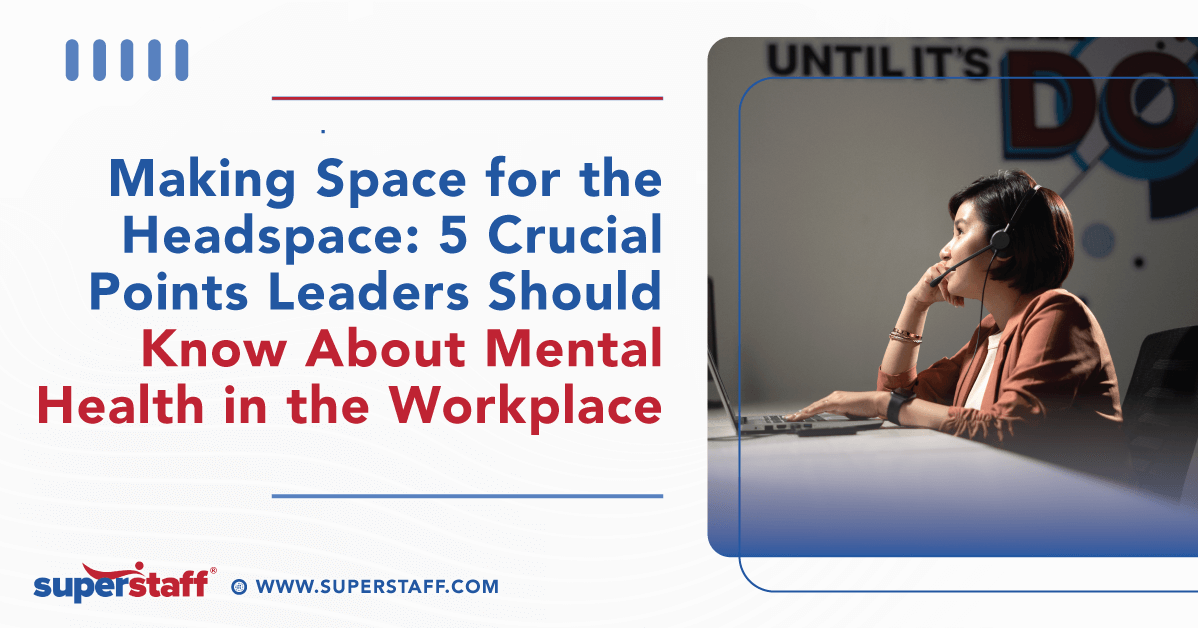
In 2008, Reuters published an article about a marketing company in Japan that offers paid heartbreak leave to its employees. Fast forward to 2020, the Japanese government signed a law mandating all employers to provide the said benefit. While the U.S. doesn’t have similar legislation, many companies radically transform their cultures, practices, and policies to put mental health in the workplace front and center.
Times have changed. Workers are now in the driver’s seat—and they demand employers take employee wellness and well-being in the workplace seriously. Leaders who recognize and evolve with this new reality are better poised to meet their hiring, retention, and post-pandemic recovery goals.
Are you ready to take on the challenge?
What Every Leader Should Know About Mental Health in the Workplace

#1: Mental Health Is No Longer a Benefit But a Workplace Imperative
Make no mistake about it. The Great Resignation is still on. And among the top factors driving the trend is the ongoing mental health struggles among workers. Workers and job seekers no longer consider employee mental health a “nice to have” benefit but a “must-have” in the workplace.
After more than two years of dealing with uncertainties and disruptions of global scale, employees are putting their foot down. If they have to choose between mental health and work, they will choose the former. Workers prioritize their overall well-being and expect potential employers to do the same.
A survey commissioned by Ginger found that employees consider mental health and wellness benefits “very important” when weighing employment opportunities. Another study found that 91% of the workers expect their employers to take employee mental health seriously and provide them with ample support, which may come in the form of the following:
- Access to health and wellness applications
- On-demand mental health counseling
- Allowance for psychological services
- Paid mental health breaks
- Health insurance with adequate mental health treatment coverage
As the labor shortage continues to hamper businesses’ ability to fulfill crucial functions, expect more employers to expand and even get creative with the benefits they offer to attract and retain talents.

#2: 2022 Is the Year of Employee Wellness and Workplace Mental Health Support
The continuous decline of COVID infection rates globally has fueled many business leaders’ optimism that 2022 will mark the beginning of “The Great Recovery.” But even as daily lives worldwide have started to show a semblance of normalcy, employers must not go back to their old ways and instead push toward a better normal.
Before COVID ripped off the band-aid solutions in existing work and business practices, companies often swept issues concerning employee mental health under the rug. But employers cannot simply brush off the magnitude and the long-term impacts of the pandemic in the employees’ psyche and, consequently, on their performance at work.
Various studies found that:
- Almost 80% of employees worry about their mental health
- 88% experienced at least one symptom of depression during the pandemic
- 78% said the pandemic affected their mental health
- 45% of adults considered seeking mental health treatment because of the pandemic
- 54% of female and 46% of male workers said their mental health has declined since the pandemic started
Credited mainly to the tight labor market, employers of all sizes have positively promoted mental health in the workplace. Many have increased their employee mental health support initiatives and even implemented drastic transformational shifts to promote well-being in the workplace.
Take a look at the following data:
- 90% of employers have increased their investments in employee mental health programs
- 86% of companies consider mental health in the workplace as among their top priorities in 2022
- 53% of employers have provided specific employee mental and emotional health programs since the pandemic
- A quarter of employers have formally implemented a well-being strategy
As the year progresses, larger investments are expected to pour into programs designed to elevate employee well-being. The top employee wellness benefits that will get more comprehensive and competitive are:
- Mental health (90%)
- Telemedicine (80%)
- Stress management and resilience (76%)
- Mindfulness and meditation (71%)
- COVID-19 vaccinations (57%)
Employers must realize that 2022 will continue to bring challenges to the workplace, mainly since the pandemic lingers. Hopefully, the growing focus on mental health at work will ultimately drive long-term, mutually beneficial, and meaningful changes in the work landscape.

#3: Successful Employee Mental Health Programs Require the Engagement of Top Executives
The level of engagement and commitment of CEOs and other top executives directly affects the success of initiatives promoting employee mental health and well-being in the workplace. Yet, many leaders appear to be oblivious about how employees perceive their efforts to address issues concerning mental health in the workplace.
According to a survey by Ginger, 96% of CEOs think their organizations are doing enough to elevate mental health at work. However, only 69% of workers share the same view. In another study, Deloitte pointed out that only 1 in 5 millennial and Gen-Z workers said their employers are doing well in supporting their physical and mental health at work.
Where is the disconnect? It could be rooted in many reasons, but the communication gap is one major factor. Since the pandemic started, 48% of millennial and Gen-Z workers have experienced increased stress and anxiety, but 60% have admitted not mentioning the issues to their employers or immediate superiors.
While many cultures have become more open to discussing mental health, the stigma still endures in the workplace. Organizations with such a dilemma must focus on building a psychologically safe environment and a culture of openness—a job that requires leaders to be more grounded and in touch with their humanity.
Step Up to the Plate by Stepping Down the Pedestal
Spearheading meaningful programs, such as providing seminars and access to therapy, are all excellent initiatives. But the most effective action a leader can take to remove the stigma surrounding mental health is to set an example. The same study by Ginger found that 90% of employees appreciate a CEO who is willing to discuss mental health at work.
However, not all leaders are comfortable displaying their vulnerable sides. Some worry that opening up about their struggles and experiences will impact their authority. For this part, management can offer support by providing leadership training that specifically addresses these challenges.

#4: Corporate Losses Due to Employee Mental Health Concerns Are Significant
The state of your employees’ mental health has a direct and significant impact on your bottom line. When employees are not in their ideal headspace, their productivity, performance, and decision-making suffer. And how much does this cost businesses?
Major depressive disorders account for about $31 billion to $51 billion in productivity losses and $10,000 in health insurance per employee annually. As workers continue to grapple with uncertainties and disruptions, analysts foresee the global costs of mental health concerns to reach more than $6 trillion by 2030.
Unaddressed mental health concerns also affect workers’ level of engagement. And when employees feel less engaged in the workplace, they are likely to resign, costing employees even more. According to Glassdoor, recruitment and rehiring cost businesses an average of $4,000 per employee.
Investing in Employee Mental Health Pays Off
Organizations that invest in improving the accessibility of mental health services for their employees are simultaneously investing in improving their business performance. Every $1 you spend on mental health prevention and intervention initiatives saves you $2 to $4 on other expenses.

#5: Starting Conversations About Mental Health at Work Is Just the First Step
As with any issue, the first and most crucial step to addressing mental health problems in the workplace is awareness. But leaders should recognize that it is indeed just that—the first step. Acknowledging that a problem exists and sparking conversations about it is not the same as addressing it.
To be clear, we are not recommending leaders embrace a therapist’s role as that is neither a healthy approach for the employee nor the leader. Instead, employers and leaders need to take an honest look at their organization’s practices and their role in enhancing or impeding employee well-being.
Are You Addressing the Symptoms or the Cause?
According to a mental health report by Uprise Health, 78% of employees said that the pandemic had affected their mental health, and among the top reasons cited are:
- Overwhelming workload (43%)
- Frustrations with leaders and co-workers (39%)
- Lack of recognition for their work (28%)
Yes, the pandemic has undeniably increased the sense of stress, anxiety, and burnout among workers. But it also pushed into the foreground many longstanding practices that have contributed to toxicity in the workplace.
Leaders must recognize both work and nonwork factors affecting employees’ mental health. Questions like, “are they burned out with too much workload due to staff shortage?” or “are our policies too inflexible for those juggling work and child care?” must be asked and pondered on regularly. In short, you have first to identify the root causes of the problems, and then create clear policies and programs to address them appropriately.
SuperStaff: Putting Employee Well-Being Front and Center Since 2009
The topic of mental health in the workplace may appear to have picked up steam just now. But at SuperStaff, employee well-being has always been a priority. We have long recognized that as a human capital business, the majority of our success lies in the hands of our people.
We make every effort to invest holistically in our employee’s wellness—from physical and financial to mental and emotional. These efforts paid off and accounted for our continuous headcount and business growth over the past years. We’ve recently expanded our offshoring operations in another growing region in the Philippines.
Recognizing how one’s physical environment affects a person’s emotional and mental state, we intentionally chose the green cities of Angeles and Clark as locations for new offshoring centers in Pampanga. We are confident that as we continue to take care of our people, they will be more empowered to take care of our clients.
Contact us to learn about our outsourcing solutions and how partnering with our happy and satisfied staff can help your company achieve your business goals while providing your internal team the much-needed support to lead healthier work lives.






